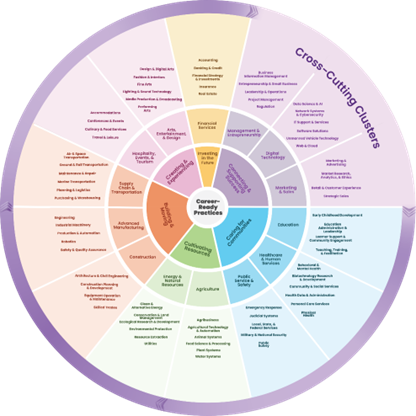CTE: 7 Things You Need to Know and Communicate
As a school counselor, your primary responsibility related to CTE is to communicate about CTE courses and experiences with students and families to help them identify any that are relevant to students' goals and, where applicable, graduation requirements.
The following descriptions will help you understand how CTE is organized, the breadth of CTE opportunities, and the most important information to share with learners and their families to help them with their choices.
CTE courses are organized and sequenced in ways that differ from academic coursework. Understanding how CTE courses relate to and build on each other can help you advise students on the most relevant course selections.
Career Clusters
The National Career Clusters® Framework, developed by Advance CTE, serves as a guiding organizational structure for careers by knowledge, skills and interests. In the most recent version, there are 14 Career Clusters such as Construction; Arts, Design & Entertainment; and Public Service & Safety, among others.
Many states use the Clusters Framework as a way of organizing their CTE program offerings. Other states may organize CTE programs in different ways, but these state-defined content areas must crosswalk to the Career Clusters for required reporting under the federal Perkins CTE Act. For instance, Nebraska has created a model that shows how the Clusters map to the state’s six content areas.
The Cluster Framework is not only a tool for organizing the CTE offerings in your state, school and district, it is also a tool for organizing career awareness and planning. By using the Clusters Framework in advising, you can help students identify their interest in broad career groups and, as they gain knowledge and skills, drill down into more specific occupations of interest. Career Clusters may already be integrated into the career planning tools in use in your state.
Programs of Study
While Clusters are a way of grouping like programs and careers across CTE, a program of study is a way of vertically organizing CTE and academic courses and experiences that are focused on a single career area. It is officially defined in federal CTE legislation as “a coordinated, nonduplicative sequence of academic and technical content at the secondary and postsecondary level.” The terms program of study, plan of study and career pathway are sometimes used interchangeably.
Most programs of study include a sequence of two to four credits worth of CTE coursework, depending on the specific state. The CTE portion of a program of study often starts with a broad, more general introductory level course, such as “Introduction to Engineering Design” and may conclude with a more in-depth capstone experience. For example, a three-course CTE sequence that gets progressively more specific is common in many states.
The program of study incorporates not only CTE courses but also academic courses that will help students reach their education and career goals:
- A student taking CTE courses in business might also take Advanced Placement or IB economics.
- A student studying agriculture may earn credit in both CTE and science through an environmental science course.
- A health care student may take a dual-credit anatomy course.
In addition, the program of study may incorporate, as applicable and relevant, the following components:
- Coursework at the local community and technical college
- Industry certifications, occupational licenses or education credentials like postsecondary certificates
- Career and technical student organizations, which are intracurricular groups like FFA (formerly Future Farmers of America), SkillsUSA and HOSA–Future Health Professionals that incorporate leadership development, career exploration and competitive events
- Work-based learning opportunities such as job shadows, internships and apprenticeships
Many states map out programs of study at the state level for schools to use, while others leave program of study development to the local level, and still others use both strategies. Regardless, in addition to the course schedules and descriptions you should have for all courses, the CTE staff at your school should provide you with sample plans of study like the examples below or a similar tool that shows course sequences and other CTE program options.
Examples:
Many CTE programs produce brochures, videos, informative websites and similar recruitment materials that describe CTE program offerings and the relevant occupations and careers for which these programs prepare students. Ideally, these tools will be available in English as well as in other languages commonly spoken in your community. These materials introduce CTE programs to students and can help you gauge learners’ initial interest in these offerings.
Examples:
CTE programs of study include a sequence of courses that build and deepen knowledge and skills in a particular career area. It is of utmost importance that students are enrolled in the appropriate level of the program sequence, so knowing which courses are pre-requisites for more advanced courses is key.
In addition, in some localities popular CTE courses are oversubscribed. In this case, students may need to complete an application, take part in an interview, have a recommendation from a teacher, or complete some other requirement to gain one of the available seats.
Furthermore, students may need to meet similar requirements to prove their readiness for experiences like CTE capstone courses, dual-credit courses or work-based learning.
An increasing number of states have incorporated CTE coursework and experiences into their high school graduation requirements as optional or required components. According to a 2023 report from Education Strategy Group:
- Fourteen states allow CTE participation to meet a graduation requirement
- Five states require CTE participation to meet a graduation requirement
- Four states mandate career preparedness courses
In Virginia, for instance, students must meet one of the following requirements to graduate: 1) complete an Advanced Placement, honors, International Baccalaureate or dual enrollment course; 2) complete a high-quality work-based learning experience; or 3) earn a CTE credential approved by the board.
Some states have also approved certain CTE courses to meet core academic graduation requirements in subjects such as math or science.
As a school counselor, you can help students determine whether and how they can meet the applicable requirements in your state through CTE.
Across the nation, CTE served 1.2 million students with disabilities on the secondary level in 2022-23. CTE is particularly effective for these learners.
CTE teachers are equipped to support students with disabilities in CTE programs using the same accommodations and modifications that are in use in core subject area classrooms. Instructional strategies like providing choice in how students demonstrate learning and offering extra time for tasks can be incorporated into the CTE classroom or lab. Assistive technology like captions and text-to-speech readers and behavior management strategies can also be used. Occupational therapists can support students with physical disabilities.
To ensure students with disabilities and their families can make informed decisions about a particular CTE program, a trial run in that CTE classroom or lab as part of a rotation through CTE programs or on a one-off basis can help. This approach may be particularly relevant to help students with autism or sensory processing disorders understand what noises, lights and other stimuli may be present.
Another tool that can help teachers and students identify accommodations for CTE is the Job Accommodation Network, which has a large library of workplace accommodation strategies and tools organized by disability type (e.g., anxiety or speech-language impairment) and limitation (e.g., attentiveness or fine motor skills).
Ideally, your state already integrates Individualized Education Programs (IEPs) and 504 plans for students with disabilities, along with other planning and mapping tools like program of study templates, into the individual learning plans, personalized graduation plans or similar that all students complete.
When advising students and families on course selection, an additional factor to consider is location and transportation. In some communities, select CTE courses, particularly programs or courses that require specialized equipment or facilities, may be offered at shared-time facilities called area technical centers, career technology centers, boards of cooperative educational services (BOCES) or similar. These institutions serve learners from across multiple areas such as schools, school districts, educational service areas and workforce development regions. If these institutions are part of the CTE program offerings in your state, students may split time between their home campus and the CTE center, which means transportation must be considered. It is often provided by the district or one of the institutions involved, but there are exceptions that require alternative solutions.
In addition, students may need to plan for transportation if dual-credit CTE courses are taught on community and technical college campuses, although these courses may also be taught online or on the high school campus by a teacher certified to teach at the postsecondary level.
Finally, students may need to plan for and secure transportation to and from work-based learning experiences at off-campus worksites. Who provides transportation – the school or district, the employer, or the student and their family – will depend on how the work-based learning experience is coordinated and what works best for the student.
In addition to transportation needs that can impact scheduling, some CTE experiences may require additional fees.
Career and Technical Student Organizations (CTSOs)
These organizations are much more than clubs – they provide CTE students with opportunities for career exploration and leadership skill development and incorporate competitive events that let students practice technical skills, employability skills and more. Most of these organizations have membership dues and chapters may travel to take part in conferences or competitions on the local, state and national levels. To help students and families cover these expenses, CTSOs frequently engage in fundraisers, but families should know that they may be required to pay some or all of these costs.
Organizations Recognized by the National Coordinating Council of CTSOs
- BPA: Business Professionals of America
- DECA
- FBLA: Future Business Leaders of America
- FCCLA: Family, Career and Community Leaders of America
- FFA
- HOSA–Future Health Professionals
- National Professional Agricultural Student Organization
- SkillsUSA
- Technology Student Association
Industry-recognized Credential Exams
CTE programs may incorporate exams that lead to industry certifications or licenses, and administering these exams comes at a cost. Many states, school districts or institutions cover the costs of at least one attempt at the exam if the assessment is integrated into the CTE program, but there may be a fee if the student needs to take the exam multiple times or if the assessment is optional.
What is a Credential?: Learn more about different CTE credentials with ACTE’s “What is a Credential?” fact sheet.
Dual/concurrent Enrollment Courses
CTE programs of study may incorporate dual-credit courses taught on the high school campus, online or on the college campus. As with industry credential exams, many states, school districts or schools pay tuition and fees for these experiences to some extent, perhaps up to a certain number of credit hours. However, there may be some cost to the student to offset tuition or cover other expenses like books and materials. Also, payment or scholarships for dual-credit courses may require that students achieve a certain GPA or other measure of success or the costs must be repaid.

Reflection Questions
The following questions can help you think through both the information and resources you have and what you might need to help you better communicate about CTE with learners and families. These questions, among others, can also be found in the fillable reflection tool.
- What brochures or other recruitment materials developed by your CTE colleagues can you share with students?
- What Career Cluster and CTE program of study maps, templates or other tools are available to help you plan with students and families?
- What, if any, eligibility requirements exist for CTE courses and experiences?
- How can CTE courses and experiences like earning industry credentials fulfill graduation requirements?
- What do students with disabilities need to know about accommodations and modifications that can help them succeed in CTE?
- How does transportation to other institutions or worksites need to be factored into a student’s schedule?
- What additional fees may families be responsible for and what financial help is available for those costs?
State-specific Info: Learn more about the CTE system in your state with our State-by-State Resource List.






